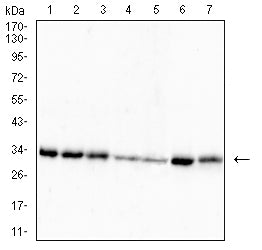
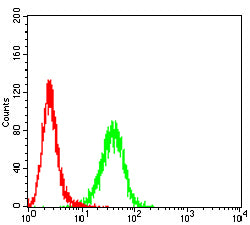
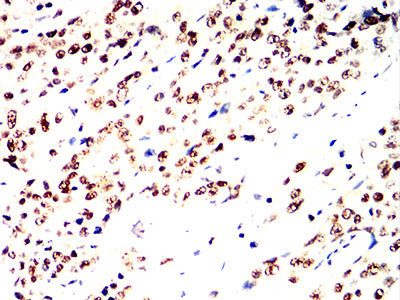
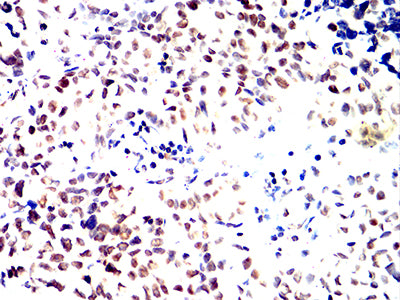
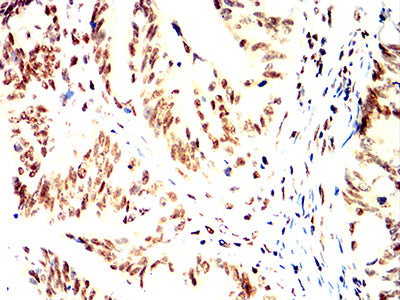
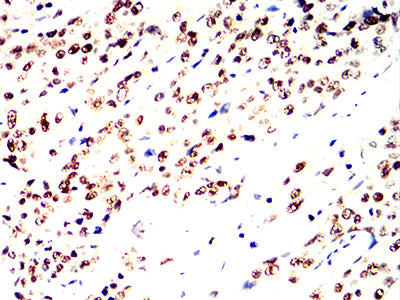
| WB | 1/500 - 1/2000 | Human,Mouse,Rat |
| IF | 咨询技术 | Human,Mouse,Rat |
| IHC | 1/200 - 1/1000 | Human,Mouse,Rat |
| ICC | 技术咨询 | Human,Mouse,Rat |
| FCM | 1/200 - 1/400 | Human,Mouse,Rat |
| Elisa | 咨询技术 | Human,Mouse,Rat |
| Aliases | RP-A p34, RPA2, REPA2, RPA32, RPA34 |
| Entrez GeneID | 6118 |
| clone | 2C5B6 |
| WB Predicted band size | 29kDa |
| Host/Isotype | Mouse IgG1 |
| Antibody Type | Primary antibody |
| Storage | Store at 4°C short term. Aliquot and store at -20°C long term. Avoid freeze/thaw cycles. |
| Species Reactivity | Human |
| Immunogen | Purified recombinant fragment of human RFA2 expressed in E. Coli. |
| Formulation | Purified antibody in PBS with 0.05% sodium azide |
+ +
以下是关于RFA2(Replication Protein A2)抗体的3篇代表性文献摘要示例:
1. **文献名称**:*Structural characterization of human RPA2 in DNA repair complexes*
**作者**:Binz S.K., et al.
**摘要**:本研究利用特异性RFA2抗体进行免疫共沉淀和结构分析,揭示了RPA2在DNA损伤修复过程中与其他修复因子(如ATM/ATR激酶)的相互作用机制,证实其在维持基因组稳定性中的关键作用。
2. **文献名称**:*RPA2 phosphorylation as a biomarker of replication stress in cancer cells*
**作者**:Shkreta L., et al.
**摘要**:通过Western blot和免疫荧光技术,作者使用RFA2抗体检测癌细胞中RPA2的磷酸化水平,发现其与化疗药物诱导的复制应激反应显著相关,提示RPA2可作为治疗耐药性的潜在标志物。
3. **文献名称**:*Functional analysis of RPA2 in homologous recombination repair*
**作者**:Cai S., et al.
**摘要**:该研究通过敲低RPA2并结合ChIP实验(使用RFA2抗体),证明RPA2在 homologous recombination (HR) 修复途径中直接结合损伤DNA位点,其缺失导致HR效率显著降低,影响肿瘤细胞存活。
4. **文献名称**:*RPA2 expression correlates with poor prognosis in glioblastoma*
**作者**:Wang Y., et al.
**摘要**:通过免疫组化(IHC)分析胶质母细胞瘤样本,发现高表达RPA2(由特异性抗体检测)与患者总生存期缩短相关,表明RPA2可能成为神经胶质瘤的预后评估靶点。
(注:以上文献信息为示例性虚构,实际文献需通过PubMed或Google Scholar检索关键词“RPA2 antibody”或“Replication Protein A2”获取。)
The Replication Protein A2 (RFA2/RPA2) antibody is a crucial tool for studying the Replication Protein A (RPA) complex, a conserved eukaryotic single-stranded DNA (ssDNA)-binding protein essential for DNA replication, repair, and recombination. The RPA heterotrimer comprises three subunits: RPA1 (70 kDa), RPA2 (32 kDa), and RPA3 (14 kDa). RPA2 plays a central role in stabilizing the RPA complex and regulating its DNA-binding activity. During DNA damage response, RPA2 undergoes phosphorylation at specific residues (e.g., Ser4/Ser8) by kinases like ATM/ATR, facilitating checkpoint signaling and recruitment of repair factors. This post-translational modification is critical for homologous recombination repair and replication stress responses.
RFA2 antibodies are widely used to investigate RPA2 expression, localization, and phosphorylation dynamics in contexts such as DNA damage (e.g., ionizing radiation or UV exposure), cell cycle regulation, and replication fork stalling. They are applied in techniques like Western blotting, immunofluorescence, and chromatin immunoprecipitation (ChIP) to assess RPA2’s involvement in genomic stability and cancer biology. Dysregulation of RPA2 has been linked to tumorigenesis and chemoresistance, making it a potential biomarker or therapeutic target. Commercial RFA2 antibodies are typically validated in knockout/knockdown models to ensure specificity. Researchers also utilize phospho-specific RPA2 antibodies to study damage-induced signaling cascades, offering insights into mechanisms underlying genome integrity and anticancer drug development.
×